From the onset, I knew that sunlight in this climate was a resource I wanted to use. Sunny, cool climates at high altitude are perfect for “active” photovoltaic systems. PV panels lose efficiency as they heat up, so cool weather is optimal. Plus at 6800 feet in altitude there is less atmosphere to reflect and diffuse sunlight than there is at sea level. Big Bear gets over 300 sunny days per year and is actually the home of a solar observatory, so this is an excellent location for solar.
My solar array is composed of eighteen 280 Watt American-made SolarWorld panels, for a total system size of 5.04 Kw. The system size was the maximum allowed by the local utility Bear Valley Electric, based on the size of my house. My system is connected to the electrical grid using a net metering system, so the meter spins backwards and generates a huge credit during the summer. Thanks to the use of microinverters, the system still generates power even when partially shaded, which happens in the early morning and late afternoon.

Solar was a no-brainer from a financial standpoint. The system costs about $20,000. However, after a Federal Tax credit of $6000 and a state rebate of $5000, the net system cost is only $9000. Electrical rates from Bear Valley Electric are much higher than national averages, about $0.36 per kwh. That means my system should generate close to $2000 worth of electricity per year.